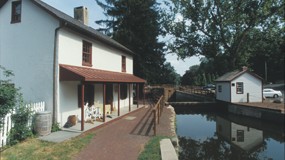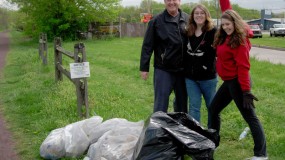Lower Bucks County Sites
Bristol Lagoon
Bristol, PA
A public-private partnership project involving over 275 volunteers has reestablished the Bristol Lagoon as a beautiful park that serves both canal visitors and the local community. The gazebo, a popular setting for wedding photos in the early 1900s, has been restored to its former glory by a local artist.
Bristol Marsh
Bristol, PA
Freshwater tidal marshes were never widespread in the mid-Atlantic region, occurring mainly along the banks of large rivers such as the Delaware and its tributaries. Since the arrival of William Penn, these fragile yet highly productive habitats have been all but eliminated by riverfront development. Bristol Marsh is the best remaining example of this vanishing natural community in Pennsylvania.
Although the marsh is small and surrounded by commercial development, six rare plants native to the Delaware River tidal marshes thrive here. Dependent on daily tidal flushing, these highly specialized wetland plants—including Indian wild rice, Walter’s barnyard grass, waterhemp ragweed, and two species of arrowhead—have been nearly extirpated from Pennsylvania. Now these and other important components of the plant community are protected, and the marsh ecosystem continues to function as a nursery, pollution filter, and water purifier for the Delaware River.
The marsh is also an isolated haven for wildlife, including many migratory waterfowl. This preserve, so close to major population centers, provides an ideal opportunity for increased public education and awareness of the critical importance of wetland habitats.
Bristol Wharf
Bristol, PA
The summer months are filled with many festivals and numerous free concerts, including Celtic Day, African-American Day, Italian Day, and Puerto Rican Day, all held at the Bristol Lions Park and Wharf along the Delaware River.
Churchville Nature Center
Churchville, PA
A facility of the Bucks County Department of Parks and Recreation, this is an area rich with diverse environments: meadow, marsh, woodland, pond and lake. People of all ages are welcomed for study, active exploration, and contemplation.
A full range of environmental programs are offered for school classes as well as scout groups. Public programs include bird walks, campfire programs, children’s clubs and a wide variety of outings and field trips.
Core Creek County Park
Langhorne, PA
Core Creek Park has1200 acres of public land, including Lake Luxembourg, with hiking trails that afford solitude while enjoying lakeside and streamside views. Some trails also accommodate bicycling and horse riding. The park offers varied wildlife habitat including white-tailed deer, waterfowl, wading birds, song birds and migrating birds. Fishing is abundant on Lake Luxembourg with the chance to catch bass, walleye, catfish, bluegill, carp and other native species. Boats are limited to those powered by electric motors. Recreational boating includes wind surfing, sail boating, canoeing and row boating.
David Library of the American Revolution
Washington Crossing, PA
The David Library of the American Revolution is a nonprofit foundation devoted to the study of American history circa 1750 to 1800. The library’s mission is the collection and dissemination of information on the period and the support of related programs. It was founded by Sol Feinstone (1888-1980), a businessman, philanthropist, and collector of Americana who emigrated from Lithuania in 1902 at age 14.
The nucleus of books and manuscripts initially donated by Feinstone has now grown to include 40,000 printed materials in bound volumes and microcards, as well as 10,000 reels of microfilm containing original American, British, Loyalist, French and German records. The collections also hold a wealth of material on women, families, African Americans, and Indians. Facilities include the research library, a conference center, and a residence facility for visiting fellows.
Five Mile Woods
Lower Makefield Township, PA
Five Mile Woods was preserved due to its environmental uniqueness. Straddling the fall line (the geological divide between the Coastal Plain and the Piedmont Plateau regions), the plant community of the woods represents a unique blend of the two divergent ecosystems. Five Mile Woods was dedicated as a nature preserve by Lower Makefield Township. Pets and bikes are not permitted.
Margaret R. Grundy Museum
Bristol, PA
Established according to the wishes of the late Senator Joseph R. Grundy, this former Grundy residence is dedicated to the memory of his sister, Margaret. Overlooking the Delaware River, the house is an outstanding example of a fine Victorian residence.
The interior of the house is an elegant statement of luxurious living. Woodwork imported from Europe is prominent throughout the house, including the carved oak paneling and staircase of the entrance foyer.
The living room, handsomely accented with cherry wood, features a fireplace with a unique double flue which frames a stained glass window. The large, paneled dining room, a room given a unique character partly because of its unusual angles and arches, contains an Italian carpet designed specially to fit the room, a heavily carved oak table, and a variety of other gorgeous furnishings. Other rooms throughout the house reveal an impressive collection of antique furnishings and works of art.
The Margaret R. Grundy Library, located nearby, can also be explored.
All tours are guided and take about 30 minutes. Groups are welcome. Large groups will be divided into smaller groups of 12 to 14 people for the house tour.
Historic Fallsington
Fallsington, PA
A seat of early Quaker settlement and site of four meetinghouses, Fallsington is the pre-Revolutionary village where William Penn worshipped. Guided tours focus on historic architecture, furnishings, material culture, and local history. Fallsington is home to culturally significant architectural styles representing the 17th through 20th centuries.
Lake Afton
Yardley, PA
This man-made pond in downtown Yardley, at Main Street and Afton Avenue, has its own duck population and offers year-round enjoyment, with fishing during the warmer months and ice skating in winter. The lake was first noted in a deed dated 1713, and mentioned in Benjamin Franklin’s “Pennsylvania Gazette” in 1731. As part of a system of dams, ponds and canals, it provided water to run grist and saw mills. It has been maintained since early 1970s by the Friends of Lake Afton.
Old Library by Lake Afton
Yardley, PA
The Old Library by Lake Afton, built in the Gothic Revival style of the Victorian era, was completed in 1878. Its arched windows lead many to think that the building was once a church, but it was always the community library. It was acquired by the Yardley Historical Association in 1977 and houses a collection of photographs, newspapers, books, and ephemera related to local history. The Library is available for weddings, receptions, and other private events. Space is limited to 55 persons.
Pennsbury Manor
Morrisville, PA
The Manor is the recreated country home of William Penn. The construction of the original manor was an expression of Penn’s belief that life in the country was more wholesome than in the worldly atmosphere of crowded cities. Pennsbury Manor is permeated with the spirit of this historical humanitarian, and it gives the visitor a sense of the unhurried grace and charm of those years when Pennsylvania was William Penn’s “Holy Experiment.”
Radcliffe Street Historic District
Bristol, PA
During the mid 1800s the wealthy and prominent citizens of Bristol built their houses along Radcliffe Street. Upper class residences, many of which were constructed during the period of the canal boom are concentrated between Market and Walnut Streets. Significant examples include the two and one-half story stuccoed brick house built in 1831 for Thomas G. Kennedy, the superintendent of the Delaware Division of the Pennsylvania Canal, William Kinsey’s c. 1834 three-story Greek Revival style brick townhouse, Kinsey’s three-story frame Greek Revival style double house and the two fine Greek Revival style frame houses built about 1847 for Charles Pierce and Dr. Augustus Guerard.
The owners and managers of the town’s mills and factories built a number of magnificent residences, almost all located along Radcliffe Street, in the last decades of the nineteenth century. These include the William H. Grundy House, the 1884 Leedom-Pursell House, the John Dorrance House, the 1894 Horace Trumbauer-designed Leopold Landreth House, the Frank Bell House, and the c. 1868 Joshua Pierce House. All of these buildings exemplify the high-style architecture built by Bristol’s economic and social elite during the decades after the Civil War.
Other significant buildings erected during this period include the 1869 St. Mark’s Roman Catholic Church, the 1877 St. James Protestant Episcopal Church Parish House at the east corner of Walnut and Wood Streets, S. A. Brouse’s 1894 Bristol High School Building at the north corner of Mulberry and Wood Streets, and the altered 1895 Methodist Episcopal Church at the east corner of Mulberry and Wilson Streets.
Riverfront Park
Bristol, PA
This is the gateway park to historic Bristol Borough on the riverfront at the lower end of the Bristol Historic District. Numerous community events are held here throughout the year, and the Bristol Riverside Theatre is located nearby.
Silver Lake Nature Center / Delhaas Woods
Bristol, PA
Silver Lake Nature Center is a 253-acre complex within the Mill Creek Valley Park system where lush foliage, accessible wetlands and rich woodlands abound. Rare and threatened animal and plant species like the Red Belly Turtle, Southern Leopard Frog, and the Maryland Meadow Beauty can be found at the Center.
The park’s lake is the terminus of the Mill Creek, Queen Anne Creek and the Black Ditch Creek Watershed. Because it contains the best-protected Coastal Plain woodland remaining in the state, the Center is unique to Pennsylvania as well as Bucks County.
Across the street, and managed as a part of the center is Delhaas Woods. This 170 acre park has several miles of walking trails passing through rare Pennsylvania habitats and near rare Pennsylvania plant species. Open sunrise to sunset.
Summerseat
Morrisville, PA
Summerseat was erected in 1773 by Thomas Barclay, a Philadelphia merchant. George Washington established his headquarters here December 8-14, 1776. Later owners were George Clymer and Robert Morris, both signers of the Declaration of Independence and Constitution. It is a stately, two-story, brick and stone Georgian structure. In the latter years of the 20th century, the house was acquired by the Morrisville School District. Basketball was played on the second floor. Today, Summerseat is owned and maintained by the Historic Morrisville Society. It is open to the public on a restricted basis.
Tyler State Park
Newtown, PA
Tyler State Park consists of 1,711 acres of park roads, trails, and facilities that are carefully nestled within an original farm and woodland setting. Neshaminy Creek meanders through the park, dividing the land into several interesting sections.
Summer recreational opportunities include hiking, fishing, disc golf, boating, picnicking and an overnight hostel. Winter activities include ice skating, ice fishing, sledding, tobogganing, and cross country skiing.
Washington Crossing Historic Park
Washington Crossing, PA
Washington Crossing Historic Park was founded in 1917 to perpetuate and preserve the site from which the Continental Army crossed the Delaware River under George Washington’s leadership. This purpose is achieved by interpreting the historical significance of this site for thousands of park visitors each year through tours, exhibits and various special events. The spirit of the 1776 Crossing is recreated every year on Christmas Day when the annual reenactment of Washington Crossing the Delaware takes place. Visitors can see reenactors in Continental military dress cross the river in replica Durham boats.
The park also preserves and interprets the early 19th century history of Taylorsville, the area in which the crossing of the Delaware occurred. This small ferry crossing of the 18th century developed into a quintessential village of the next era, reflecting progress, American ideals and the new industrial age.

